By Paul Helinski
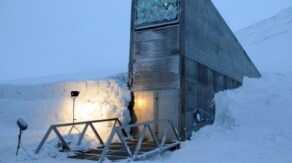
Seedvault – Keeping seeds more than a few years is not a sound practice for long term survival. This is the international seed vault that is buried in the Artic, because even freezing seeds in electric freezers can be fraught with problems. Learning how to garden and save your own seeds is the only viable method to have a hope at growing food down the road. Do it now so you don’t have to guess later.
The most difficult thing to set aside for yourself in this day and age is time. But unfortunately, when it comes to surviving the end of life as we know it, time is the one thing you will have to set aside if you plan to get serious. Disasters are easily survivable. Put away enough food and water, and you can ride out most storms, even lengthy ones. But if the food supply never comes back online, what do you do then? Gold and silver won’t be worth anything because, short of the tin pot dictator or monarch who eventually takes over, nobody will have any use for such trivialities. Eating will be everyone’s #1 long-term concern, and if you plan to survive, you have to learn right now how to grow your own food. Right now you have the luxury of making mistakes and still being able to eat. So figure it out! Where can I go, whom can I partner with, what resources can I put together that will give me a long term chance of survival? Since it is spring, and in many parts of America the planting season is around the corner, I figured that this is a good time to talk about seeds. Buying a “survival seed vault” isn’t going to cut it for you if you have never grown food before. You have to get out and get gardening this spring. Don’t be shy. An old farmer once told me that farming is nothing but problem-solving, so get out there and figure out your problems now, and how to solve them.

If you plan to take my advice and get gardening, it is worth a $40 membership to The Seedsavers Exchange. There you will find tons of heirloom veggie seeds at reasonable prices from seed savers all over the world.
Buying Seeds
As you might imagine, the seed industry is huge. For this reason you have to be very wary of the “big business” side of buying seeds. But on the other side, trying to avoid big business can also end up costing you way too much for seeds. Unless you really have a desire to get taken, don’t pay a premium for survival seeds, and don’t get taken in by promises of purity or long term storage life. Most of the misinformation out there comes from “GMO” warnings. There is no such thing as a “GMO” tomato, for instance, in the market today (though they do exist in laboratory greenhouses). So if someone is trying to sell you “NON-GMO” tomato seeds, most likely they are trying to capitalize on your ignorance. GMO is a concern,for corn, soy and potentially zucchini. But other than that, there are no real commercial GMO crops approved in the United States.
If you plan to save seeds from year to year, what you do need to be concerned about is what is called an F1 Hybrid. Think of them like a mule, which is a cross between a horse and a donkey. Try to breed two mules and you’ll get nothing, and that is often what you get when you try to pollinate one F1 Hybrid with another, or save seeds from one in hopes of growing more of that variety. An F1 is usually hand-pollinated from two varieties with vastly different properties, and they have been the poster child of selective breeding for decades. Most F1s are created for mass production destined for supermarkets because they lend themselves to machine handling and long shelf life. But the seeds you get at Walmart and Home Depot are often also F1 Hybrids, grown and marketed for the home garden. They are engineered for large size, great taste and high yields.
Those are all great things if you are able to buy seeds again next year. Seeds are relatively cheap. But if you want to save the seeds yourself for next year’s garden, you may find that the veggies from year two resemble nothing of year one, if the seeds are fertile at all. “Heirloom” seeds are varieties that don’t require any cross pollination, and you can save seeds of those varieties from year to year without a loss of quality or yield. Many of these varieties used to be supermarket standards, until low prices and high margins dictated that machines do most of the fresh vegetable sorting and that a tomato had to have a shelf life of over a month. These days you will rarely find an heirloom veggie for sale outside of a local farm stand, but the seeds are available. Heirlooms usually taste better and look better but have a shorter shelf life. They also may not be as sweet, in the case of corn and peas, but they actually taste like corn and peas, not corn syrup. Many of the packet seeds these days at Walmart and Home Depot will carry an “heirloom seeds” emblem because the home gardener has become more savvy in the last ten years or so. The heirloom package seeds are often also labeled “organic,” and you’ll pay at least $2 a pack for them instead of 50 cents. For casual gardening and seed saving these are fine, but you can get a much better buy, as I’ll cover below.
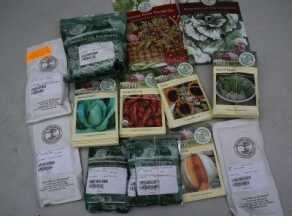
This is a fairly large order I put in for this year, and as you can see, they sell small packets and big bags, depending on what you need.
Seed fertility is also something that you shouldn’t pay extra for, and it is also and more commonly known as the “germination rate.” You can control how many seeds in a pack actually sprout by buying your seeds from reputable sources or sources that other people have verified are selling new, fertile seeds. Just beware that when you see an advertisement for “survival seed banks,” normally seeds only have a couple years of shelf life until fertility begins to fall off , and the “survival” market is historically feast or famine. When it is hot, the stuff flies out at high prices. But at times like today, where most people feel that things are getting better and not worse, survival supplies generally sit on the shelves and in the Ebay stores and don’t move. It is pretty easy today to buy seeds that were saved in 2012 for the 2013 spring growing season.
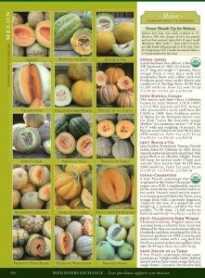
Don’t get overwhelmed with varieties. Just pick a few different seeds because you are going to mess up your first batch of plants probably.
By some opinions, you can offset the limits of seed fertility life by freezing the seeds, but not all seeds react kindly to freezing. The biggest problem with freezing your seeds is that most home freezers have an automatic defrost cycle, in which parts of the freezer are allowed to defrost so that the coil doesn’t ice up. So depending on where in your freezer they are, your seeds may be thawed and frozen over and over again. And what about power outages? An international seed vault was actually established in the Artic for this reason. You don’t have to worry about the power going out or your coils freezing over in the Artic. But in middle America that happens all the time. You are best to just keep your seeds dry and in a fairly cool constant temperature rather than storing them in your freezer, I think. Then plan to replace them every couple years.If you intend to become an avid gardener, in preparation for Armageddon of course, think about joining The Seed Savers Exchange. It is an Iowa-based non-profit. Membership is $40 per year, and it gives you access to a giant catalog of pretty much every heirloom vegetable you can think of, plus all the standards varieties. Call them at 563-382-5990 if you can’t join online, which I have found to be a challenge. Seed Savers is a group of traditional gardeners who have committed themselves to planting and trading heirloom vegetables and fruits. They publish an actual source book of varieties, and it is often three inches thick. In the source book you will find hundreds of varieties each of beans, peas, tomatoes, carrots, onions, beets, lettuce, melons, etc., all broken out with colors, flavors, yields and growing specifics. You order the seeds directly from the sources listed in the book, not from The Seed Savers Exchange. Once you are a member, you can also view the entire catalog online and if logged in, contact the seed growers directly. It is an incredible resource.
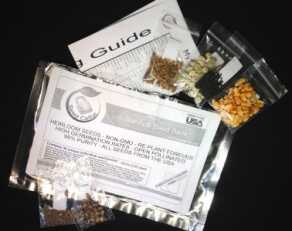
This is the package that you get from the Ebay seller called MySeedCellar, which I have so far found to be the absolute best buy. Big fat packs of seeds, plus some planting and seed saving guidelines, inside a Mylar envelope for all of sixteen bucks.
Seed Savers also now sells seeds itself, and for this article I bought a bunch of them, as you’ll see. The seeds from Seed Savers are sold at a premium because they are certified to be exactly what you are paying for, and free of selective breeding or hybridization of any kind. I have also bought premium seeds from Johnnys Selected Seeds. They are far and away not your average Burpee seeds in hardware store packets, because while Burpee seeds will often grow, I doubt you will have as much success growing them two years from now.
The cheapest and most expedient way to buy “survival seeds” is, dare I say it, from survival seed suppliers on Ebay. I recently tested a package of 8,500 seeds from a seller called MySeedCellar, and they nearly all germinated within a week. This week I ordered a bucket of 600,000 seeds from Mozybeau Farms. The tag line on the bucket of seeds is “Heirlooms Forever.” Well, if you save the seeds, it might be heirlooms forever, but first you have to not screw it up. The Mozybeau order was actually a big disappointment because most of the stuff on the page of the ad is not in the bucket. You have to be careful, and if I were you, stick to MySeedCellar (which is also myseedcellar.com btw). I decided while writing this article to try one more, “Survival Essentials,” because they are running it at half price and it might be worth a gander. With anything but MySeedCellar, open the Mylar package and make sure you got what they are advertising. I will add here that there are hundreds of sellers from all over the world selling “heirloom” seeds on Ebay. It is worth some cool, cheap experimenting if you are into it. I have grown interesting heirloom veggies for years and there is nothing like it.
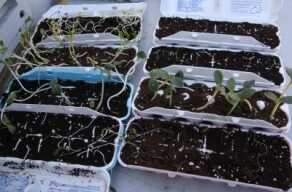
I actually ruined my seedlings because the MySeedCellar seeds germinated quicker than I had anticipated, and the little plants grew too fast looking for light while trapped inside the egg boxes.
You Will Probably Screw It Up
Screwing it up is your primary concern, and it is why you really have to start gardening now and saving seeds from year to year. Even if you do it on a very small scale and also plan to replace your purchased seed stock every couple of years, you have to get gardening. I am an experienced gardener and managed to screw up a whole bunch of seeds I planted a couple weeks ago, simply because I didn’t check them for a few days when I went away. They sprouted earlier than I expected, and because I had them in closed egg containers and no light, the seedlings grew too long and many today are not salvageable. If you start gardening now, even in containers on your back porch, not only will you witness the absolute something-from-nothing miracle of growing your own food, you’ll also figure out how to not screw up because of a lot of popular misconceptions about gardening.
For instance, water, you will find, is your friend, but also your enemy. You will always have either not enough of it or too much. Therefore you have to make provisions to either carry water to your plants, or drain water away when they have too much… or both. One dry weekend away from your plants can cause them to wither, and a punishing rain and flood can rot them out, all in the same week. You see from the pictures that I use egg containers to start seeds. They are great, but beware that you have to let the young plants dry out or you’ll choke them with too much water. Predators are not going to be the least of your concerns. Pests you call them? I don’t. Try fawning over heirloom tomatoes for two months only to have them successfully flower, and then they are eaten by tomato worms before the tomatoes actually come out. How about watching your beautiful lettuce grow, only to find the patch overrun by rabbits the night before your neighborhood barbecue that you had intended to feed an heirloom salad from your impressive garden. Too late is too late when it comes to garden predators, and if you start gardening now you will get a good idea of who is going to try to eat your garden before you do.
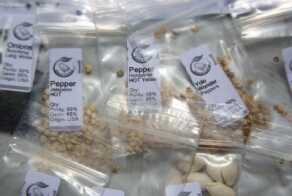
Each packet from MySeedCellar has more than 10 times what you get in a standard packet from the big box stores and home centers.
First and foremost, protect your garden with a fence. And while I wouldn’t suggest that you plant your survival garden in the front yard come the day you need survival food; I don’t think that two legged predators are your worst enemy. In many parts of the country, hogs are a huge problem, and you will lose your garden to them unless you have a strong fence with barbed wire and mesh. Rabbits and other seemingly harmless herbivores will generally stop at a chicken wire fence and not try to dig under, but beware of groundhogs and other burrowing creatures, because they can do some damage.Insects are a whole other story. As part of your experimental garden experience, contact your local Extension Service and see what information they can give you for expected insects and pest for your area and crop plans. They will also be able to suggest insecticides that work well in your area, and many of them will even test your soil for PH and trace minerals. If you plan to go “organic,” it takes some real practice, and you have to source the inputs well in advance. Healthy crops are bug resistant but they are not bug proof, and daily attendance in your garden is going to be an absolute must until you get through a season or two of successful growing.
I am not a proponent of organic gardening practices for survival. Is it preferable and “sustainable?” Yes, it is, but it is also fairly risky to not have some fertilizer on hand. Vegetables require a proper PH and certain levels of NPK, Nitrogen, Phosphorous, and Potassium. If you are going organic, you still have to add those things through methods other than chemical fertilizer, in the same quantities that you would achieve with chemical fertilizer. It takes a lot of cow manure to equal a little bit of fertilizer, and the manure has to be tilled in and aged a bit prior to planting. The thing about soil that you have to understand is that there is a limit to how much you will get out of one patch of ground without adding things to it. You may start with great soil in year 1, but by year 3 you better add some manure, or compost that has high nitrogen. Good old chemical fertilizer is much better. I am keeping fertilizer in my survival supplies. You should too.
Bugs are much the same. I have tried a lot of “organic” methods for bug control, including hanging soap on my plants and spraying them with compost-soaked water. None are sure bets. For year #1 of planting, plan to use at least mild pesticides. Then you’ll see what you get, and if it survives. Plants have enemies that are big and fat like caterpillars, right down to microscopic nematodes and fungi. Healthy, vibrant plants that have all the nutrients they require tend to be fairly resilient, but you just never know when one species of moth caterpillar is going to land on your plants and eat them up in a day. After you get through year #1, and you have the freedom to go organic, try a percentage of your crops without fertilizer and pesticides, then as you succeed you can move to a more sustainable system. Unless you want to certify organic with the government, it is no big deal to use chemical fertilizer one year and cow manure the next.
Plants Like to Grow
The most important thing right now is to go buy some seeds and plant them. It is the easiest way to witness an actual miracle in our time right in front of your eyes. Plant a tiny tomato seed into a lump of dirt, water it, and a week later you’ll see the plant start to rise. All of that stuff you see came from that tiny seed, with only the addition of some water and sunlight. If there is evidence of the original “something from nothing” of creation, it is in the growth of that seed.
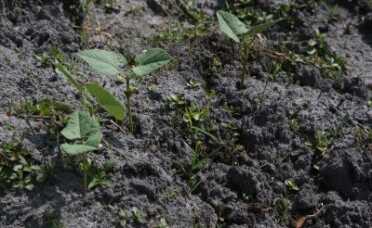
This is a proof of concept garden started with seeds from MySeedCellar. It wasn’t even tilled first. The dirt was just dumped here. As you can see, the weeds came in before the plants, and the process begins on the way to actually veggies. These are zucchinis, which will grow well no matter how much you screw them up. Enjoy your new adventure in the garden! It’s a lot of fun.
The Web is full of information about gardening, and a lot of it is actually true. Don’t get caught up in spending a lot of money on intricate methods to grow veggies. If you have some soil that is something besides sand, till it up and plant your seeds, about twice their thickness deep, and water them, but don’t over-water them. Let the soil get dryish before you re-water. All but corn can be started in the house if it is still too cold out there, but corn sends down a taproot first. I’ve started all kinds of things indoors that supposedly you can’t transplant, but as soon as they poke through make sure you get them some good sunlight. You can direct-seed all of the big seeds with good results, as long as you are past your last frost. Don’t worry about blowing it your first try. That’s the whole point. Farming is about problem solving, and you’ll run into your first problems right away, sure enough. Who knows if the Yellowstone volcano is going to blacken the skies. Who knows if the Russians and Chinese are going to nuke us. Who knows if nothing is going to happen bad and the future is so bright we will have to wear shades? Gardening will add a lot of quality to your life and build a skill set that may or may not be extremely useful if Armageddon ever shows its ugly head.

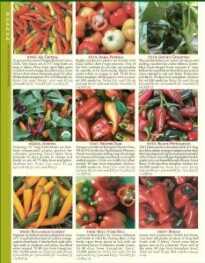

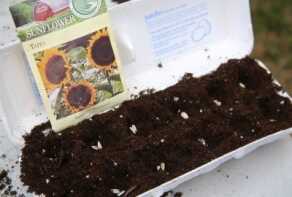
Some awesome pointers here. Definitely right about the screwing up part though. I can say that from experience. I had a tough time getting everything right when I first started out gardening. I’m a little better now after some trial and error. I tend to get my seeds from Sustainable Seed Company, come to think of it, they have a few good looking “prepper style” packages too. http://sustainableseedco.com/survival-seeds/
My brother is an engineer and inventor. He sells seedlings (cuttings) and niche market seeds primarily to countries over seas. He can’t keep up with the orders. He told me not to store my seeds in plastic as it is an off gassing endocrine disruptor and bad for seeds. Keep in mind his seeds are picky, but still it may be a problem for regular stuff. This makes sense on an intuitive level. He has also done seed germination experiments, and you are right there is a lot to it we don’t know; he can talk my ears off without me getting half of it! So I plan to go to the local hardware with paper envelopes, fill them, and use whatever I have space for, then carry over some. I have a bag of sunflower seeds for the birds. In an emergency the sunflower sprouts will be my first crop.
GMO=Genetically MUTULATED organism. See an article in
http://www.DiscoverTheNetworks.org
What a great article. While reading I went on to ebay and found MySeedCellar, ordered the 5k seed pack, will be trying several different things, including an indoor verticle garden.. Thanks again for the great article.
As far as keeping deer, rabbits & other varmints out of the garden, I plan on planting inside my 1-acre fenced front yard (7-foot wood privacy fence mostly, with some 6′ chain link & welded wire tied to board fence). Since I have a number of dogs I can have 24/7 coverage inside the fence during the growing season. Starting my first garden this year, just to get in practice.
I will fence off the garden inside just to keep the dogs from destroying the crops.
Not a perfect solution for everyone’s situation, but a fence is usually a good idea for SHTF environment anyway. And even if you only have one or two dogs, that will usually keep deer, rabbits & coons away.
At the top of my head, there’s also GMO wheat and sugar beets.
Nice article. 🙂
Here’s another bit of advice: If your life is going to depend on crops from a home garden, you had better grow those crops in a greenhouse. Not only will you extend the growing season, you’ll also be able to control access that will filter out garden pests.
Took me clicking on 6 or 7 article headlines before I finally found one that actually defined GMO (genetically modified organism). It’s nice to know exactly what the letters stand for. Anyway, great article. I’ll show it to the other half and maybe we can make a family project out of gardening for the future (that we hope doesn’t ever come to being). I’m sure my six grandkids will find this of interest as well. I’m 69 and we always plant a small garden, even involving the GK’s, so this will just be taking things to a whole new level. Many “Thanks” for bringing this to our attention.
Read the others in this series from the top navigation bar.
Took me clicking on 6 or 7 article headlines before I finally found one that actually defined GMO (genetically modified organism). It’s nice to know exactly what the letters stand for. Anyway, great article. I’ll show it to the other half and maybe we can make a family project out of gardening for the future (that we hope doesn’t ever come to being). I’m sure my six grandkids will find this of interest as well.
I LOVED THIS!!! It will help me tremendously this year, I just planted my first seeds and I think I am over-watering them so thank you for the article. One correction, there are now many GMO crops in the U.S.–
Extent of worldwide use of GM crops
In 2012, GM crops were planted in 28 countries; 20 were developing countries and 8 were developed countries. 2012 was the first year in which developing countries grew a majority (52%) of the total GM harvest. 17.3 million farmers grew GM crops; around 90% were small-holding farmers in developing countries.[97]
Country: USA
2012– GM planted area (million hectares)[97]
GMO crops planted: Corn, Soybean, Cotton, Canola, Sugarbeet, Alfalfa, Papaya, Zuchinni Squash
Here is the full article:
http://en.wikipedia.org/wiki/Genetically_modified_crops
I have been gardening most of my life of 49 years. I grow produce for local market sale.Gardening doesnt seem complicated to me.. Once you learn the rules it’s pretty straight forward. Mother nature is your friend and your enemy at the same time. There are lots of signs that mother nature give you each season and from year to year. For instance, 1; watch bois d arc trees. Once they leaf out the chance of frost is pretty much gone. 2; if you have grasshoppers and a hot dry summer followed by a mild dry winter, the next year they will be even worse. They can destroy crops and even fruit trees quickly.
Anyway, in a survival situation. You will also need to learn what produce can be stored and or preserved for food over the long winter and how to save or preserve them. Also what produce will supply you with the most nutrition. Example,peas, beans, sweet potatoes are high in nnutrients and can be saved for winter. Lettuce is mustly water and won’t keep you from starving.
just a little food for thought.
It is funny how people in the north assume that things are always like they have them. Everywhere has its own issues.
Hello, This is Steve with MySeedCellar.com. And no we haven’t sold out at all. We have all the seeds you guys can order! We keep a large inventory on hand, no prior heads-up needed here. I did notice a slight jump in the traffic coming in to the site and wanted to drop you guys a line. If anyone has any questions please feel free to ask, call or email. Nice article. It’s good to see that someone out there is giving our products a fair unbiased review! Unlike alot of companies, we love talking to customers and appreciate your business!
thanks so much for this series of articles. Just one suggestion. Please give the companies mentioned in your articles a heads-up so they can prepare for the onslaught of orders. thanks again
Soooooo, MySeedCellar sold out did they? I forgot to let them know.
These prepper articles are good information. Unfortunately, depending on the nature and speed of the collapse scenario, most people reading it will be dead long before they can grow and produce enough food to prevent disease and starvation. Given the current practice of computer based on-demand distribution of groceries, the average grocery chain store might have three days to a week of groceries actually in the store. If the supply chain is interrupted abruptly for an extended period – that’s how long civility will last.
The first three months after a systemic collapse will decide the survivors. The survivors will initially be composed of two classes – those prepared for the collapse and those that prey on the prepared – the predators. Again, many of the survivors will survive by predation on other survivors – and their resources – especially food stocks – stored or growing.
While food storage and production is good to know – the most valuable information for people will be strategies of how to survive the first three to six months until the population density and competition has declined enough to be supported by available resources- and things like gardening are possible again. I suggest reading the “Jakarta Pandemic” by Steven Konkoly for an a well imagined and detailed example of how a rapid collapse might affect you – in this specific case one caused by a new flu virus. Or, in reality and more probably a bioweapon – the most probable way of reducing the worlds most over populated regions by set percentages and less populated ones to cultivate for future invasion by the more populace instigators.
Of course this is only one (rapid) collapse scenario. Actually, slow collapses (like the Great Depression) caused primarily from economic downturns may not be as deadly as the rapid collapse, but their misery will be likely be infinitely prolonged – making them much more difficult to effectively prepare for.
Long past experience. Open pollinated seed corn will yield from 25 to 75% less than hybrid seed corn. Found that out the hard way ‘one’ time.
Another time, Dad had a little 1 – 1/2 acre on the wrong, for us, side of the creek. He had some 5 year, or older, seed corn he decided to plant, and see if it would come up. It did. All summer long. Three years is my limit. Tops!
Feral hogs! I would hope that I would never see anyone turning some loose around my area. The worst thing is, I fear they will be every where any way. Advice. Kill every feral hog you see. I raised domestic hogs for 40 years. They perhaps are not the most destructive animal on the face of the earth, but they are ‘really’ close.
I remember when ‘every’ family had a garden. They ‘are’ a lot of work, and also a learning process. Learn to do it ‘before’ you have to live from one. (figure on the coons getting into your sweet corn the night before ‘you’ do.)
We used to do it. (still do, just not as much as we used to) You can do it. Good Luck.
I bought a few of these packs last year from myseedcellar and they germinated quick like these. Buying more this week from them too. Grew really well and produced alot better than the stuff I used to by in the little packs. The only problem I had was keeping the deer off my pumpkins….. They ate the tops off half my plants! In a survival situation I guess the pumpkin plants would make good “Deer Bait”
How about the canned seeds? Any feedback? Also, I thought there was a commercially produced tomato with a Flounder gene in it to help keep it from rotting?
Made but not produced. For canned, I don’t think there is a huge advantage to canned seeds. There is very little documented evidence that seeds last longer oxygen starved. Would it hurt for $18 to have one of those Auguson farms cans at walmart online? Of course not.
I was concerned with not having access to electricity and being able to let it set on the shelf? I thought the canned seeds had a 10 year shelf life, maybe I’m wrong. What about the flounder tomato?
Those tomatoes were experimental and push back from Europe prevented them from getting into the market from what I remember. The problem with seed research is that there is very little of it because the people who do ag research want you to buy new seeds every year. The small time growers are very close to the vest with what they learn. After 10 years you’ll get some germination most likely, provided you have kept them at a constant fairly cool temperature for ten years. Or if you solid freeze them you might have better results. But there is more not known about this stuff than there is known. Google around and you’ll see all the self appointed experts who use their one anecdotal case to prove out a supposed rule. Some idiot puts his myseedcellar pack in he back of his freezer next to the coil, then takes them out two years later and tells you that they didn’t germinate, but he never learned that his kitchenaid freezer has a defrost cycle. 10 years is a hope and a prayer, and if someone is advertising that I would be suspect of how fresh the seeds are to begin with. I suspect that myseedcellar and others are using last year’s discount bulk purchased seed to begin with.
So, what do you do to keep your neighbors from stealing from your garden in the middle of the night?
Security is coming a couple down the road.
Since your in a survival situation, I’d say, claymores, trip wires (noisemaker) and 45ACP
🙂
Excellent article that covers all aspects of planting. It’s my fifth year of planting and growing heirloom beans, and I’m still learning. The rewards are fulfilling. Nothing like bean soup made from your own dried bean mix with a nice ham hock for flavor!
Watch out for those critters. . . We’ve got them all here in SW Michigan. They are especially tough on plants when the beans first germinate and are sprouting.
Great advice on partnering up with a savvy farmer. There is such a guy living next door, but he’s gay. Is it OK to partner up with him?
gp